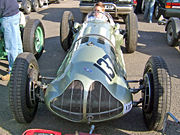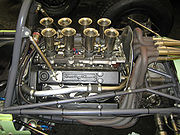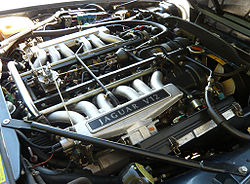
Walter Hassan
Encyclopedia
Walter Hassan OBE, C.Eng.
, M.I. Mech.E.
(1905–1996) was a distinguished UK automotive engineer who took part in the design and development of three very successful engines: Jaguar XK, Coventry Climax and Jaguar V12 as well as the ERA racing car.
Walter Thomas Frederick Hassan was born in London 25 April 1905. His father, of Irish
descent, owned a clothes store in Holloway
, North London
. His natural interest was always in mechanical things. As it was told, his uncle encouraged him to be a creator since his uncle was building model ships.
He studied at Northern Polytechnic
(now the University of North London
) and then Hackney Technical Institute of Engineering. The Regent Street Polytechnic has also been named.
's newly founded Bentley Motors
, employee #14. He was a fitter in the engine shop then in the chassis shop gaining a complete experience of the 3 litre cars then in production.
He eventually moved to road testing working under the head of experimental department (Today's R&D) Frank Clement, the company's professional racing driver, and was a riding mechanic in some races. Off-season he was part of the Bentley Motors service department.
Establishing himself as the best Bentley mechanic he was allotted to Woolf Barnato, their top driver and Bentley Motors chairman and shareholder. They established a close and lasting friendship.
After it was put into liquidation and taken over by Rolls-Royce Limited
at the end of 1931 Hassan left Bentley Motors and worked for Woolf Barnato
. In 1933 he started to build a racing car, it would become known as Barnato Hassan, and was one of the fastest cars ever to lap Brooklands. Later he developed a car for Bill Pacey, named Pacey Hassan. It was a success on the British racing circuits in the 1936 season. By now he had become a family man and accordingly sought out more stable employment. He had married in 1933 and they were to have four children.
 Wally then spent time at Raymond Mays
Wally then spent time at Raymond Mays
' E R A
at Bourne in Lincolnshire working there with Peter Berthon on engine development and at Brooklands with Thompson and Taylor on ERA chassis development.
The vast majority of prewar ERAs are still in existence, and they have continuous and verifiable provenance. They still compete in historic events despite the youngest being nearly seventy years old.
, later Jaguar Cars, as chief R&D engineer at Coventry
. When the war started he moved to Bristol and worked on engine development for the Bristol Engine Company. At the end of the war he returned to Coventry to continue to work with Bill Heynes
on what became their XK
engine.
This engine remained in production with various displacements from 1948 until 1992.
It powered the winning car at Le Mans in 1951
, 1953
, 1955
and 1957
.
 In 1950 Hassan joined Harry Mundy
In 1950 Hassan joined Harry Mundy
at Coventry Climax
, and they with Claude Baily designed the FW series (featherweight) lightweight overhead camshaft
engine intended for fire pumps
but further developed for motor racing.
In Colin Chapman
's cars they had great successes in the Le Mans 24 Hours, Formula 2 and Formula 1 twice bringing the world championship to Jim Clark
and Team Lotus
.
This engine was also used in cars like the Lotus Elite
.
 Coventry Climax was bought by Jaguar in 1963 and, now back with Bill Heynes, Heynes Hassan and the Coventry Climax team developed a Jaguar V12 engine
Coventry Climax was bought by Jaguar in 1963 and, now back with Bill Heynes, Heynes Hassan and the Coventry Climax team developed a Jaguar V12 engine
.
In later years, Le Mans
-winning Jaguars were powered with this V12 engine.
A 7.0-litre V12 based on the production 5.3-litre engine powered the winning Jaguar XJR-9
in June 1988.
A Jaguar XJR-12
powered by a 7 L 60 degree SOHC V12 won in June 1990. During that race it covered 4882.4 km at an average speed of 204.036 km/h / 126.782 mph with a maximum trap speed of 353 km/h / 219 mph.
Chartered Engineer (UK)
In the United Kingdom, a Chartered Engineer is an engineer registered with Engineering Council UK . Contemporary Chartered Engineers are master's degree-qualified and have gained professional competencies through training and experience...
, M.I. Mech.E.
Institution of Mechanical Engineers
The Institution of Mechanical Engineers is the British engineering society based in central London, representing mechanical engineering. It is licensed by the Engineering Council UK to assess candidates for inclusion on ECUK's Register of professional Engineers...
(1905–1996) was a distinguished UK automotive engineer who took part in the design and development of three very successful engines: Jaguar XK, Coventry Climax and Jaguar V12 as well as the ERA racing car.
Walter Thomas Frederick Hassan was born in London 25 April 1905. His father, of Irish
Northern Ireland
Northern Ireland is one of the four countries of the United Kingdom. Situated in the north-east of the island of Ireland, it shares a border with the Republic of Ireland to the south and west...
descent, owned a clothes store in Holloway
Holloway, London
Holloway is an inner-city district in the London Borough of Islington located north of Charing Cross and follows for the most part, the line of the Holloway Road . At the centre of Holloway is the Nag's Head area...
, North London
London
London is the capital city of :England and the :United Kingdom, the largest metropolitan area in the United Kingdom, and the largest urban zone in the European Union by most measures. Located on the River Thames, London has been a major settlement for two millennia, its history going back to its...
. His natural interest was always in mechanical things. As it was told, his uncle encouraged him to be a creator since his uncle was building model ships.
He studied at Northern Polytechnic
Polytechnic (United Kingdom)
A polytechnic was a type of tertiary education teaching institution in England, Wales, and Northern Ireland. After the passage of the Further and Higher Education Act 1992 they became universities which meant they could award their own degrees. The comparable institutions in Scotland were...
(now the University of North London
University of North London
The University of North London was a university in the United Kingdom from 1992 to 2002. On 1 August 2002, it merged with London Guildhall University to form London Metropolitan University. The former University of North London premises now form the new university's north campus, situated on...
) and then Hackney Technical Institute of Engineering. The Regent Street Polytechnic has also been named.
Bentley
Wally's first job was as a 15 yr-old shop boy in W. O. BentleyW. O. Bentley
Walter Owen Bentley, MBE engineer; designer of aero engines, designer and racer of motor cars, founder of Bentley Motors Limited in Cricklewood near London.He was known as "W.O." without any need to add the word Bentley....
's newly founded Bentley Motors
Bentley
Bentley Motors Limited is a British manufacturer of automobiles founded on 18 January 1919 by Walter Owen Bentley known as W.O. Bentley or just "W O". Bentley had been previously known for his range of rotary aero-engines in World War I, the most famous being the Bentley BR1 as used in later...
, employee #14. He was a fitter in the engine shop then in the chassis shop gaining a complete experience of the 3 litre cars then in production.
He eventually moved to road testing working under the head of experimental department (Today's R&D) Frank Clement, the company's professional racing driver, and was a riding mechanic in some races. Off-season he was part of the Bentley Motors service department.
Establishing himself as the best Bentley mechanic he was allotted to Woolf Barnato, their top driver and Bentley Motors chairman and shareholder. They established a close and lasting friendship.
After it was put into liquidation and taken over by Rolls-Royce Limited
Rolls-Royce Limited
Rolls-Royce Limited was a renowned British car and, from 1914 on, aero-engine manufacturing company founded by Charles Stewart Rolls and Henry Royce on 15 March 1906 as the result of a partnership formed in 1904....
at the end of 1931 Hassan left Bentley Motors and worked for Woolf Barnato
Woolf Barnato
Joel Woolf Barnato was a British financier and racing driver, one of the "Bentley Boys" of the 1920s. He achieved three consecutive wins out of three entries in the 24 Hours of Le Mans race.-Early life:...
. In 1933 he started to build a racing car, it would become known as Barnato Hassan, and was one of the fastest cars ever to lap Brooklands. Later he developed a car for Bill Pacey, named Pacey Hassan. It was a success on the British racing circuits in the 1936 season. By now he had become a family man and accordingly sought out more stable employment. He had married in 1933 and they were to have four children.
ERA

Raymond Mays
Thomas Raymond Mays CBE was an auto racing driver and entrepreneur from Bourne, Lincolnshire, England.He attended Oundle School, where he met Amherst Villiers, leaving at the end of 1917. After army service in the Grenadier Guards in France, he attended Christ's College, Cambridge...
' E R A
English Racing Automobiles
English Racing Automobiles was a British racing car manufacturer active from 1933 to 1954. Currently the ERA trademark is owned by a British kit-car manufacturer.-Prewar history:...
at Bourne in Lincolnshire working there with Peter Berthon on engine development and at Brooklands with Thompson and Taylor on ERA chassis development.
The vast majority of prewar ERAs are still in existence, and they have continuous and verifiable provenance. They still compete in historic events despite the youngest being nearly seventy years old.
Jaguar
In 1938 he joined SS Cars LtdSS Cars Ltd
SS Cars Ltd was a British car maker. It grew out of the Swallow Sidecar Company and was first registered under the new name in 1934. Some conjecture to the origins of the SS name exist, It was John Black who when asked the meaning of SS said it has always stood for Standard Swallow...
, later Jaguar Cars, as chief R&D engineer at Coventry
Coventry
Coventry is a city and metropolitan borough in the county of West Midlands in England. Coventry is the 9th largest city in England and the 11th largest in the United Kingdom. It is also the second largest city in the English Midlands, after Birmingham, with a population of 300,848, although...
. When the war started he moved to Bristol and worked on engine development for the Bristol Engine Company. At the end of the war he returned to Coventry to continue to work with Bill Heynes
William Heynes
William Munger Heynes , born in Leamington Spa, was a British automobile engineer.Heynes was educated at Warwick School from 1914 to 1921 before joining the Humber Car Company in Coventry in 1922 where he worked in the drawing office before becoming head of the technical department in 1930...
on what became their XK
Jaguar XK6 engine
The renowned Jaguar XK dual overhead camshaft inline 6-cylinder engine was introduced in 1949 and continued in manufacture until 1992. It was produced in five displacements for Jaguar passenger cars, with other sizes being made by Jaguar and privateers for racing...
engine.
This engine remained in production with various displacements from 1948 until 1992.
It powered the winning car at Le Mans in 1951
1951 24 Hours of Le Mans
The 1951 24 Hours of Le Mans was the 19th Grand Prix of Endurance, and took place on June 22 and 23 1951.This race saw the death of French driver Jean Larivière within the opening laps of the race.-Official results:-Did Not Finish:-Statistics:...
, 1953
1953 24 Hours of Le Mans
The 1953 24 Hours of Le Mans was the 21st Grand Prix of Endurance, and took place on June 13 and 14 1953. It was also the third round of the World Sportscar Championship....
, 1955
1955 24 Hours of Le Mans
The 1955 24 Hours of Le Mans was the 23rd Grand Prix of Endurance, and took place on June 11 and 12, 1955. It was also the fourth round of the World Sportscar Championship....
and 1957
1957 24 Hours of Le Mans
The 1957 24 Hours of Le Mans was the 25th Grand Prix of Endurance, and took place on June 22 and 23 1957. It was also the fifth round of the World Sportscar Championship.-Official results:-Did Not Finish:-Statistics:...
.
Coventry Climax

Harry Mundy
Harry Mundy was a British car engine designer and motoring magazine editor.He was educated at King Henry VIII School in Coventry and went on to serve his apprenticeship with Alvis. He left them in 1936 to join English Racing Automobiles in Bourne, Lincolnshire as a draughtsman...
at Coventry Climax
Coventry Climax
Coventry Climax was a British forklift truck, fire pump, and speciality engine manufacturer.-History:The company was started in 1903 as Lee Stroyer, but two years later, following the departure of Stroyer, it was relocated to Paynes Lane, Coventry, and renamed to Coventry-Simplex by H...
, and they with Claude Baily designed the FW series (featherweight) lightweight overhead camshaft
Overhead camshaft
Overhead cam valvetrain configurations place the engine camshaft within the cylinder heads, above the combustion chambers, and drive the valves or lifters in a more direct manner compared to overhead valves and pushrods...
engine intended for fire pumps
Airport Crash Tender
An airport crash tender is a specialised fire engine designed for use at aerodromes and airports in aircraft accidents.Airport Crash Tenders are extremely powerful machines...
but further developed for motor racing.
In Colin Chapman
Colin Chapman
Anthony Colin Bruce Chapman CBE was an influential British designer, inventor, and builder in the automotive industry, and founder of Lotus Cars....
's cars they had great successes in the Le Mans 24 Hours, Formula 2 and Formula 1 twice bringing the world championship to Jim Clark
Jim Clark
James "Jim" Clark, Jr OBE was a British Formula One racing driver from Scotland, who won two World Championships, in 1963 and 1965....
and Team Lotus
Team Lotus
Team Lotus was the motorsport sister company of English sports car manufacturer Lotus Cars. The team ran cars in many motorsport series including Formula One, Formula Two, Formula Ford, Formula Junior, IndyCar and sports car racing...
.
This engine was also used in cars like the Lotus Elite
Lotus Elite
Not to be confused with the Lotus Elise.The Lotus Elite name was used for two vehicles from Lotus Cars.-1957:The first Elite or Lotus Type 14 was an ultra-light two-seater coupé, produced from 1958 to 1963....
.
Jaguar V12

Jaguar V12 engine
Jaguar V12 piston engine was one of the premier powerplants of the 1970s and 1980s. It was first seen in the Series 3 Jaguar E-type of 1971 and was based loosely on an earlier design intended for a Le Mans car, the ill-fated Jaguar XJ13. The V12 was only Jaguar's second engine design to go into...
.
In later years, Le Mans
24 Hours of Le Mans
The 24 Hours of Le Mans is the world's oldest sports car race in endurance racing, held annually since near the town of Le Mans, France. Commonly known as the Grand Prix of Endurance and Efficiency, race teams have to balance speed against the cars' ability to run for 24 hours without sustaining...
-winning Jaguars were powered with this V12 engine.
A 7.0-litre V12 based on the production 5.3-litre engine powered the winning Jaguar XJR-9
Jaguar XJR-9
The Jaguar XJR-9 is a sports-prototype race car built by Jaguar for both Group C and IMSA Camel GTP, debuting in at the 1988 24 Hours of Daytona....
in June 1988.
A Jaguar XJR-12
Jaguar XJR-12
The Jaguar XJR-12 is a sports-prototype race car built by Jaguar for both Group C and IMSA Camel GTP. The car is famous for winning the 1990 24 Hours of Le Mans....
powered by a 7 L 60 degree SOHC V12 won in June 1990. During that race it covered 4882.4 km at an average speed of 204.036 km/h / 126.782 mph with a maximum trap speed of 353 km/h / 219 mph.

